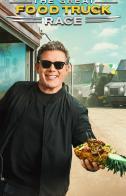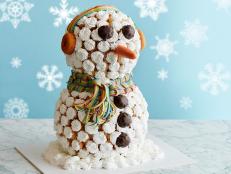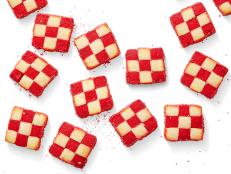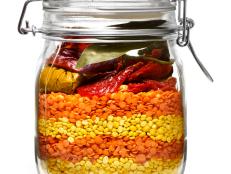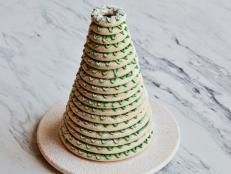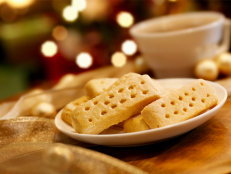This Beloved Family Dish Is Always on My Orthodox Christmas Table
My grandmother made Podvarok every Christmas, and now I do too.

Photograph by Irina Janakievska
When I was young, we always celebrated Christmas with my grandparents in Skopje, North Macedonia. I vividly remember one Badnik (Christmas Eve) in the early 1980s, and can still picture the path my parents and I walked through the old Turkish Bazaar of Skopje, over the ancient Turkish stone bridge on the Vardar River. It was a short walk from our apartment to my grandparents’, but the Vardarec wind was bitterly cold on that early January morning and the city was covered in snow.
When we arrived outside of my grandparents’ door, I began singing a Kolede song. In North Macedonia, the morning of Badnik — which we celebrate on January 6th, followed by Bozik (Orthodox Christmas) on January 7th — is known as Kolede. Children go from home to home to wake each household up with Kolede songs (carols) and receive treats — it is an old Slavic custom now incorporated into the Christmas traditions of many parts of the Balkan region. I remember having a little red sack with me at the time, and thrusting it out hopefully when my grandfather and grandmother opened the door. They animatedly joined in the singing with me. When the song was over, they engulfed me in the biggest hug and filled my sack with chestnuts, walnuts, clementines, apples, and a few chocolate and real coins.
We bustled into the warmth of the apartment, exchanging greetings and well-wishes with the rest of my family who were already there. My grandmother ushered us to the living room and immediately offered us food from a coffee table beautifully arranged with mezze (small appetizers) including turshija (fermented summer vegetables) and various winter salads: roasted red pepper with garlic and herbs; lemon pickled leek with olives; shredded sour cabbage sprinkled with Bukovo chili flakes. To accompany the mezze and keep everyone amused until our Badnik feast was ready, my grandfather passed around little glasses of golden homemade rakija (brandy) to the adults. My grandmother then hurried off to finish preparations and I adoringly, but unhelpfully, followed her around.
Not long after, amidst increasingly raucous laughter, my grandfather turned on the radio, and a lunchtime show called “Songs of Our Youth” filled the room. The show featured iconic songs of a bygone era from the former Yugoslavia, which were also intermingled with a selection of Italian canzone and French chansons. These songs were often the soundtrack to our family’s meals, and they signaled imminent feasting for us.
Before we began our feast, we gathered on my grandparents’ balcony to light a yule oak branch to commemorate Badnik. Then we squeezed around the dining table which had been extended into my grandparent’s kitchen to accommodate all of us.
Get the Recipe: Duck Leg Podvarok with Macedonian Salad
The feast began as it did every year, with my grandmother cutting the kravajche — a type of soda bread made for Badnik that has a silver coin hidden inside it. She cut one piece for God, one piece for home, and then one for every member of our family. Silence descended as we all looked for the coin. Shortly after, joyous chatter erupted as we found the coin nestled inside the piece cut to represent the home! Finding it there meant that good health, happiness, and luck would be in store for everyone in our home in the year to come.
My grandmother then brought out one of my family’s favorite festive dishes — podvarok. Podvarok is a baked casserole made from sour cabbages. Although historically podvarok was a vehicle for different types of meat and poultry, nowadays it is typically prepared with pork or without meat. As Badnik represents the last day of the Nativity fast, the feast is traditionally prepared without meat, eggs, or dairy, so on this occasion, my grandmother had prepared a meat-free version of podvarok with sour cabbages, rice, sauteed leeks and sweet paprika. This is the version of podvarok I still love the most, and now make for my family’s own Badnik celebration. As part of my research into the history of Balkan cuisine, I came across a cookbook from the 1950s referencing how podvarok could be made with turkey, goose, or duck. This inspired me to create this version, which combines my grandmother’s Badnik podvarok with duck legs, something I believe both my grandparents would have loved.
That Badnik, my grandmother had truly surpassed herself. As well as the podvarok we had a whole trout from Lake Ohrid that was baked to perfection with garlic, parsley, lemon, and white wine. There was also tavče gravče, a Macedonian-style bean bake, flavored with sweet paprika and mint. Our Badnik feast had an incredible supporting cast of side dishes too: a salad of tomatoes, grilled peppers, and sliced onions in a simple vinaigrette; several types of savory pastries including pita, a type of Balkan hand-stretched leaf pastry, filled with leeks and rice; numerous vegetable preserves, including ajvar (a red pepper and aubergine preserve) and ljutenica (a spicy pepper, tomato, and aubergine relish). For dessert, we indulged in slices of delicately roasted pumpkin, a sweet pita with pumpkin, walnuts and cinnamon, and my mother’s beautiful baklava with crushed walnuts and cinnamon soaked in a lemon syrup.
Our Badnik feast ended with counting; it is a custom in North Macedonia for everyone celebrating to taste at least twelve different foods on Badnik. That day, we all gave up counting after we reached twenty. I am certain my grandmother’s podvarok was on everyone’s list; we had mopped the beautiful, traditional clay baking dish in which she had prepared the podvarok clean with the remaining pieces of our Badnik bread.
Irina Janakievska is a food writer and recipe developer who lives and works in London, UK. She started a project called the “Balkan Kitchen” where she shares her love of Balkan cuisine. She can be found on Instagram at @balkankitchen.





